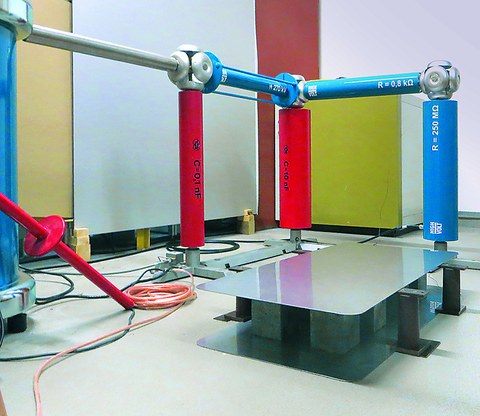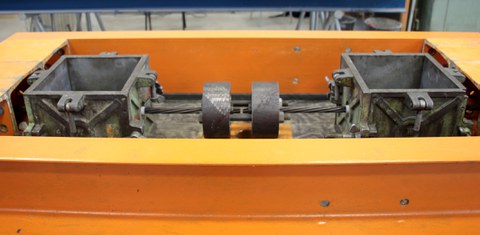Influence of electrical, thermal and mechanical loading on reinforced UHPC (KoHöMaT)
Table of contents
Project data
|
Titel | Title |
Report in the year book 2016
UHPC in the ultrasonic test

Storage of the concrete specimen in the DC field
For new high voltage power lines, compact masts are needed in order to minimize the occupied space and to blend nicely into the surrounding landscape. In the joint research project KoHöMaT (compact highest voltage masts and cross arms), 7 project partners from both civil and electrical engineering are developing solutions for pylons made of ultra-high performance concrete (UHPC).
For this reason, our institute and the Institute of Electrical Power Systems and High Voltage Engineering (IEEH) of the TU Dresden are studying the material parameters of UHPC. For the intended use, the electrical resistance and the possible interactions between mechanical and electrical loads is of importance.
It was analysed, e.g. if the concrete’s texture changes when it is constantly subjected to an electrical field. Because of the mast’s compact geometry, the distance between the concrete and the transmission line conductors is relatively small. This leads to electrical field strengths that are much higher than the usual values in the construction industry. To simulate the entire lifetime over a short time period, an electrical field strength, five times higher than to be expected, was used in the experiments.
At the age of one month, the test pieces were exposed to either a direct current or to an alternating voltage field for three months. The changes in the texture were compared to control samples, which were stored in a climatic chamber for the same duration.
Both compaction of the matrix through hydration, as well as micro cracks influence the ultrasonic transit time, which was determined at precise measuring points before and after the test pieces were subjected to an electrical field.
Furthermore, stiffness and uniaxial strength were determined. After one month in the electrical field, the test pieces showed no significant differences to the control sample. After three months, the reference piece showed a small compaction in the structure and a minimal increase in strength. This behaviour was less marked in the test pieces subjected to an electrical field. The strength and texture density remained similar to that observed before subjecting the samples to either a direct current or to an alternating voltage. This means that electrical fields don’t endanger the durability of UHPC.
Report in the year book 2015
When a strand meets a strand

Strained strands – casting the pull-out specimens with prestressed steel strands
A transition to renewable energy requires construction of new high voltage power lines. The power grid should not only take minimum space, but it should also be carefully fitted in the surrounding landscape. For this reason, the pylons are required to be as compact as possible. A close cooperation between civil and electrical engineers is required to solve the challenges resulting from bringing the conductors closer to the load bearing structure. In the joint research project KoHöMaT (compact highest voltage pylons and cross arms), seven project partners are developing together solutions for tubular steel pylons and pylons made of centrifuged ultra-high performance concrete (UHPC) to be used as compact highest voltage pylons while minimizing the impact on the landscape. The material parameters of UHPC are studied at our institute in cooperation with the Institute of Electrical Power Systems and High Voltage Engineering (IEEH) of the Technische Universität Dresden.
The important parameters for the intended use are not only the mechanical strength or the modulus of elasticity, but also the electrical resistance and thermal conductivity of UHPC. For this task, it is often required to develop new specimen types and experimental procedures. The first results, for instance, showed that the concrete behaves as an insulator although far not as good as ceramic.
The influence of electromagnetic fields on the bond between concrete and steel reinforcement is studied with the help of pull-out tests. During this tests an electric current, corresponding to the current that can be maximally induced in the real conditions into the reinforcement, is applied to the rebar. This causes an increase of the rebar´s temperature up to 80 °C. The current induction process is repeated in 700 cycles in which the bar is heated and then cooled back to room temperature. The comparison of the maximum bond stress of the evaluated samples to the reference samples showed no significant influence in case of the normal reinforcing steel. The influence on the bond of prestressing tendons is now under investigation. During the experimental work, the tendons were prestressed to one fourth of their yield capacity to ensure that strands are always aligned in the same manner. Based on the current experimental results, there is no evidence that would put the applicability of UHPC for high voltage towers in question.
Report in the year book 2014
Energized concrete

Pull-out test
The wind blows in the north, but much of the industry is in the south – Germany’s change to renewable energy requires the adjustment of the electric power transmission. The required power grid has a great impact on the landscape; it also takes up a lot of space. With the aim of keeping the required space as low as possible, compact high-voltage pylons are currently developed. Lattice towers are replaced by spun concrete masts made of ultra-high performance concrete (UHPC). The power lines are positioned as close as possible to each other, in such a manner that the width of the power grid can almost be reduced by half. The required space for the foundations is then only a tenth.
However, some things have to be clarified before these masts can be built. What is the optimum mast geometry so that the power lines don’t touch the ground and all loads can be safely absorbed? How should the insulators, which separate the power lines from each other, be constructed? Which UHPC has all the technological characteristics which are required for the centrifugation process and – at the same time – all the characteristics which are required for ultimate and serviceability limit state? There are still questions about the foundation, the connection of the elements and the carrying capacity.
Scientists at TU Dresden are testing the electrical resistance of UHPC: is it a conductor or an insulator? How does the resistance change when it rains or the mast’s surface is dirty? What happens in the composite material in case of a lightning strike or a short circuit? Do the magnetic fields of the power lines have an influence? Does the induced current in the reinforcement or the induced heating damage the materials after some time?
First tests revealed that concrete is an insulator although by far not comparable with the values of ceramics. Apart from this, first pull-out tests, following thermal stressing, were conducted. In a realistic setting, the sample was heated to 80 °C by applying a current of 155 A to the steel reinforcement and then it was left to cool down to room temperature again, altogether more than 700 times. In subsequent pull-out tests we didn’t get any significantly different results compared to samples which had not been pre-treated. Overall, results from the tests conducted show so far no evidence which might question the suitability of the use of UHPC in high-voltage pylons.
